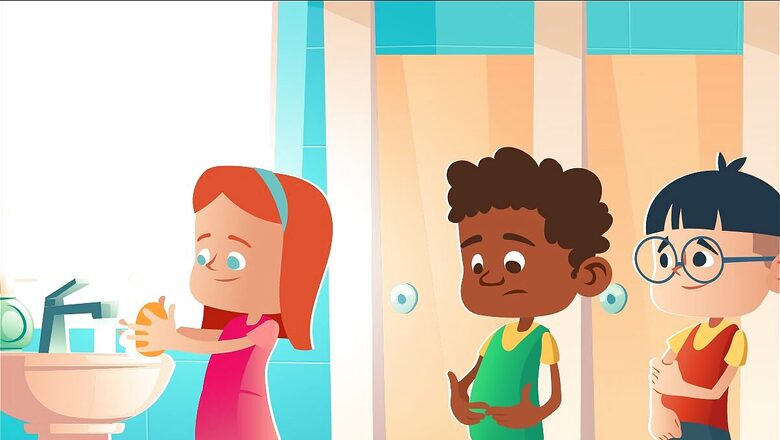
views
Before the Swachh Bharat Mission, talking about toilet hygiene and toilet habits was taboo, unless you count toilet humour. Today, many of us are aware of the impact access to toilets can have, to someone who has never used one.
However, the hesitation to talk about toilet hygiene persists, especially when it comes to our children. This is unfortunate, as children need to be trained to use the toilet properly. Potty training aside, a child needs to be shown (repeatedly!) how to practise toilet hygiene by developing the correct habits.
These practices are essential for preventing infections, diseases and many avoidable problems such as:
- Urinary tract infections (UTIs), are caused by bacteria entering the urinary system through the urethra and cause pain, burning, fever and blood in the urine. They are more common in girls than boys, but can affect anyone who does not wipe properly or wash their hands after using the toilet.
- Diarrhoea is caused by viruses, bacteria or parasites that enter the digestive system through contaminated food, water or hands and can cause dehydration, malnutrition and weight loss. It can be especially dangerous for young children and people with weak immune systems.
- Pinworms are tiny worms that live in the intestines and lay eggs around the anus and can cause itching, irritation and insomnia. They can spread easily through contact with infected clothing, bedding or hands.
- Skin infections, such as rashes, boils or abscesses, which can occur when bacteria enter the skin through cuts or scratches. Skin infections can cause pain, swelling and pus. They can also lead to more serious complications such as cellulitis or sepsis if left untreated.
These problems can affect not only the physical health of children, but also their mental and emotional health. Children who suffer from poor toilet hygiene may feel embarrassed, ashamed or isolated from their peers. They may also develop low self-esteem, anxiety or depression. These feelings can interfere with their learning, socialising and happiness.
How to break the taboo?
One of the main reasons why people avoid talking about toilet hygiene is because it’s been a cultural taboo. However, taboos are not universal or fixed and can vary from place to place and change over time.
Here are a few reasons why toilet hygiene is considered a taboo:
- It involves bodily functions that are seen as dirty, disgusting or shameful.
- It exposes private parts that are supposed to be hidden or covered.
- It challenges gender norms that expect girls to be clean and boys to be rough.
- It violates social etiquette that expects people to be polite and discreet.
Now, when you think about it logically, none of these reasons, singly or taken together, justify not talking to children and taking the risk of developing the diseases and infections we’ve noted above! On the other hand, talking to children about toilet hygiene benefits everyone. It helps to:
- Educate children about their bodies and how they work.
- Empower children to take care of their health and hygiene.
- Encourage children to ask questions and seek help when needed.
- Reduce stigma and discrimination against people who have different needs or preferences.
- Promote respect and empathy for others who may have different cultures or backgrounds.
Talking to Children About Toilet Hygiene
Having conversations with children about toilet hygiene is easy – they haven’t yet developed the funny biases that the rest of us have. Every parent charts their own path, however, here are some basic guidelines that everyone agrees with.
Start early: The best time to talk about toilet hygiene is when children are young and curious. They are more likely to listen and learn without feeling embarrassed or judged. You can use books, toys or games to introduce the topic in a fun and age-appropriate way.
Be honest: The worst thing you can do is lie or avoid answering children’s questions about toilet hygiene. Instead, be honest and explain things in a simple and clear way. Use correct terms for body parts and functions, such as penis, vagina, urine and faeces. Avoid using slang that may confuse or mislead children.
Be positive: The best way to make children feel comfortable and confident about toilet hygiene is to be positive and supportive. Praise them for doing things right, such as wiping properly, flushing the toilet and washing their hands. Avoid scolding them for doing things wrong, such as making a mess, forgetting to flush or using too much paper. Instead, gently remind them of what they should do and why it is important.
Be respectful: The most important thing to remember when talking about toilet hygiene is to be respectful of children’s feelings and preferences. It can be counterproductive to force them to do something they are not ready or willing to do, such as using a public toilet, switching from diapers to underwear or trying a different product. Do not tease them or make fun of them for having accidents, fears or questions. Do not compare them to other children or expect them to follow your standards. Instead, listen to them and understand their needs and concerns. Help them find solutions that work for them and make them feel comfortable and safe.
Creating a Culture of Openness About Toilet Hygiene
What we talk about matters. When we educate our children about toilet hygiene we are investing in our collective future. These children will grow up with healthier attitudes, and act as agents of change in their own communities.
Harpic, India’s leading brand in the lavatory care segment, recognises this and has directed several outreach programs towards schools and school children. Harpic has also partnered with News18 in the Mission Swachhta aur Paani Initiative, which has, for 3 years now, championed the cause of inclusive sanitation, equality for all genders, abilities, castes and classes and the strong belief that clean toilets are a shared responsibility.
Under the aegis of Mission Swachhta aur Paani, Harpic partnered with Sesame Workshop India, an educational non-profit, to promote positive sanitation, hygiene knowledge and behaviours among children and families through schools and communities, engaging with 17.5 million children across India.
It also empowers parents to have all the right conversations with children (and their teachers, if need be) by providing information on any and all topics related to toilet hygiene and toilet access. Join us here, to educate yourself on these topics through articles, videos, panel discussions and much more, and help us move the needle towards a more Swachh and Swasth Bharat.




















Comments
0 comment